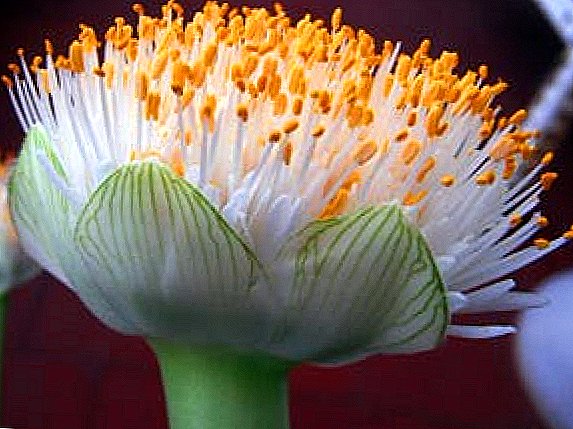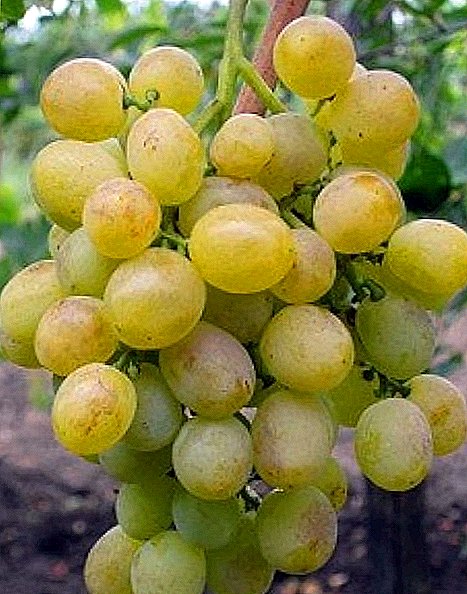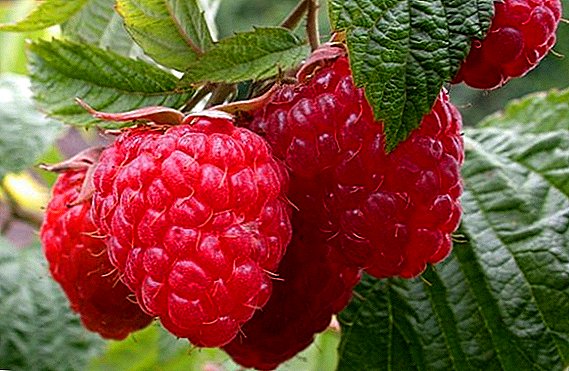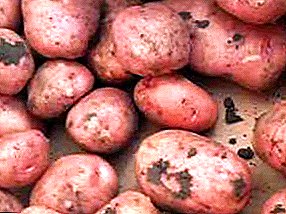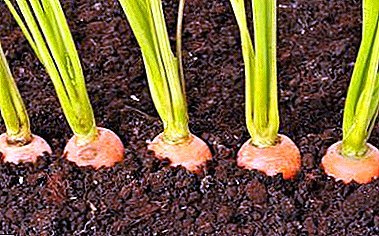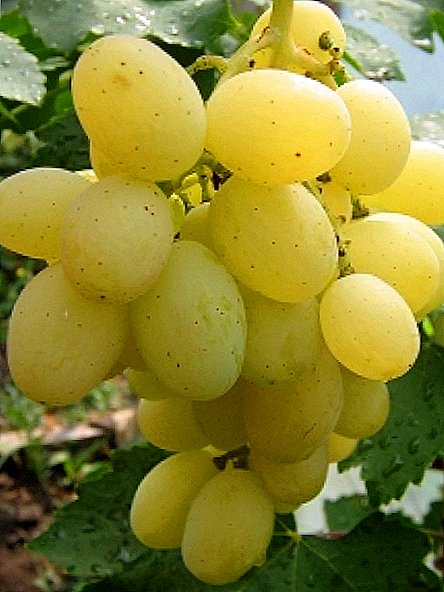
It is very difficult to meet a person who would be indifferent to grapes.
Even the inhabitants of the South, seemingly spoiled by the immense abundance of varieties of these delicious berries, are still not indifferent to them.
But, even despite all the spoiledness of the southerners, both they and the residents of other climatic regions highly appreciate this kind of grape like Kesha.
It is about this early table grape variety and will be discussed below.
Our goal is not to praise the Kesh variety, but to tell in detail about its main advantages and disadvantages, devoting our readers also to the details of planting and caring for them.
Grapes "Kesha" - get acquainted with the characteristics of the variety
This variety is very often confused with its follower - the Kesha-1 variety. However, the second variety was bred a little later and, unlike Keshi, its ripening dates are later, although the growth force of the bush and the grapes is a little more "Keshi-1". Also, the second grade has a higher resistance to frost and diseases.
The advantage of the Kesha variety is the richer taste of the berries and the ability to self-pollinate.
It is important to note that the variety "Kesha-1" has a couple more names - "FV-6-6", "Talisman" and "Super Kesha". There is also a variety called "Kesha-2", also known as "Tamerlan", "Zlatohor" and "Kesh Muskatny" grapes.
"Kesh-2" is the result of breeding the varieties "Kesh-1" and "Kishmish Radiant", due to which this variety ripens quickly and has large clusters of amber-colored berries; its taste qualities have a pleasant nutmeg shade. The variety "Kesh", which will be described in detail below, was produced by Russian breeders who used this variety "Froomoasa Albe" and "Delight".
It is worth noting that very often it is the Kesha grape variety that is also referred to as "FV-6-5" or "Delight Superior."
Grapes bunches "Kesha" - an extraordinary creation of nature
The clusters of grapes of this variety, although not very neat in shape, look very attractive and appetizing. In particular, they are very large, reaching in weight of 1.2 kilograms, although the usual weight of the bunch is about 1 kilogram. With plenty of harvest, the weight of the clusters can be reduced to 0.6 kilograms.

The shape of the clusters is usually conical or conical-cylindrical. The berries are placed very tightly, but not structured, which often gives the clusters a shapeless appearance. The comb, that is, the leg of the bunch, in the Kesha variety is usually very long and fastens it very well to the escape of the vine. It is important to note that almost all the shoots of this variety are fruitful, and two clusters of very large size can form on one shoot.
Berries on clusters are also formed very large, on average, their size is within the limits of 32x25 millimeters. The average weight of these berries is about 10-12 to 12-15 grams. The shape of the berries is oval, very attractive. The skin color is creamy white. Berries differ in dense pulp, light transparent color, resembling dragee.
The berry also contains seeds, the number of which is only 1-3, which is very much appreciated by lovers of fresh grapes. The taste of the berries is very pleasant, rich, harmonious. Tasters taste grapes "Kesha" rated at 8 points. There is a very high content in the chemical composition of sugar berries. So, with acidity indicators of only 5-8 g / l, the indicators of sugar content are 19-24%.
Grapes "Kesha" refers to table grapes. Most often grown for sale and fresh consumption. It looks very attractive when serving with the help of the table. Due to the high content of sugars in its composition, it is used to make white wine.
Characteristics of yield grapes "Kesha"
It is unlikely that this variety would be highly valued if it had poor fruit bearing. Thanks to vigorous bushes with a strong root system and flowers of both sexes, grapes are able to self-pollinate and delight very abundant crops. In particular, yields are formed on 80% of all shoots of a bush, and the maximum load with eyes of an adult bush is no less than 35-40. It is noted that the number of clusters capable of forming on one sleeve of a bush corresponds to the age of the bush itself.

The first crops of the grape bush "Kesha" begins to delight only at the age of 4-5 years. However, by using the grafting variety as a form of reproduction on an old stem, it is possible to achieve much quicker bush entry during the fruiting period. Variety fructifies regularly, but requires care and fertilizing.
Grapes are ripening in the early or mid-early periods. The vegetative processes of the vine take place over 122-130 days.
- The main advantages and distinctive features of the Kesha variety
- Early ripening time of grapes.
- High yield and large sizes of clusters and berries, which have a very pleasant and full-bodied taste. Variety "Kesha" is considered one of the elite grape varieties.
- High availability of grapes for transportation.
- Fast and productive ripening of shoots, capable of bearing 1-2 clusters.
- There is a very good suitability of the cuttings for rooting.
- High stability of a grade before low temperatures - can easily transfer to-23ºС.
- High resistance grapes "Kesha" to the mildeen.
- Disadvantages varieties "Kesha" and ways to increase productivity
- With a bountiful harvest, clusters can form much less than usual.
- This variety is best to plant on perennial wood of old grapes. In this way, you can achieve rapid and effective growth of the grape bush.
- Despite the fact that in general the variety is able to respond well to fertilizers, it cannot be fed with urea (that is, with nitrogen).
It is also interesting to read about the correct planting of grapes in the fall.
The rules of planting grapes varieties "Kesha" - what you need to know?
This variety has its own preferences and requirements for planting, without which it is difficult to grow a good grape bush. First of all it concerns the soil on which you are going to grow grapes. It should be as fertile as possible, better suited. black soil. It is important to take into account that it is not overly wetted and that the groundwater is at a depth of at least 1.5 meters.
After all, the grape bush of this variety is very branched and has a large root system, which can easily get water from the depth, but in case of excessive moistening it can rot, the quality of fruits will decrease.
It is important to choose the right place for landing. It is better to plant it near the buildings, from their southern side. Thus, the grapes will receive a lot of sunlight and it will be much easier for you to build a support for weaving it. Also, the wall of the building will protect it from the wind. Free grapes can be planted only in the southern regions.
We select the right time for planting grapes "Kesha"
Grapes can be planted in spring and autumn. Everything will depend on what type of planting you choose and in what climatic region you live. You can plant grapes as with the help of seedlings, and the method of grafting on the shtamb grape. Seedlings are best planted in the spring, after the air temperature rises to 15 degrees, and the soil temperature is not lower than 10ºС (the same temperature conditions should be taken into account during autumn planting).
Grapes can be grafted by cuttings throughout almost the entire vegetative period. After all, it is possible to inculcate both a “black” cutting to a “black” stem, and a “green” to “black”, and use both a green cutting and a green stock.

Instructions to the correct planting of the Kesha grapes
- Pit for grape seedlings need to be prepared in advance. If you plan to plant in the spring - you can dig it back in the fall, for prematurely filling the bottom of the pit with a mixture of fertile soil and stubborn humus (thus, you need to make a small mound on its bottom).
- The distance between the pits should be at least 1 meter. At the same time, it is necessary to retreat from the wall of the building by 40 centimeters. If the seedlings are planted freely, then the distance between them is better to increase to 1.5 meters.
- It is necessary to plant a seedling carefully, because at a young age its roots are very fragile. It is necessary to lower the seedling into the pit to such a depth that the grafting site and its root collar remain above the soil surface.
- The soil can be mixed with mineral fertilizers to fill the pit, but in no case it is recommended to use nitrogen, as it can have a detrimental effect on the root system of the grapevine.
- Having poured a hole, the seedling should be poured abundantly so that the soil is better compacted (you need to use at least 30 liters of water, but taking into account the moisture content of the soil).
- A seedling must be tied up to a support driven into the soil near it.
- If planting is carried out in the fall, then before the onset of winter it is necessary to warm the seedling. To do this, you can use a tub without a bottom: place it around the seedling and cover it with soil.
Grafting grapes "Kesha" cutting on an old stock
In the event that you decide to replace the old grape variety with Kesha on your plot, it is better not to uproot the old shrub, but to plant a new sort of stem in the stem. Due to this, a new grapevine grows much faster and enters fruiting more quickly. For this you need:
- Prepare the cuttings in advance, cut them with a wedge and hold them before planting in the ox. To speed up the formation of the roots, before planting, the cut part of the cutting can be placed in a solution of a special preparation called “Humate” (for the solution, you should use no more than 10 drops of the preparation per 1 liter of water).
- Also, during the grafting for the winter, the stalk is recommended to paraffin. To do this, paraffin is dissolved in water and after it boils and floats on the surface, the cutting is dipped into it for a few seconds and immediately immersed in cold water for cooling.
- Bush shrubs are also carefully prepared. First, you need to cut off the old bush and wipe all the splinters in place of the cut - the surface of the trunk should be perfectly smooth. Secondly, the shtamb must be very carefully split with the help of a small ax and a hammer. The split should be such that only a cutting can fit into it. A strong split can irreparably damage the shtamb.
- If the stem is large, then more than one cutting can be grafted onto it.
- The grape "Kesha" is visited in the split and tightly weave with cloth and twine (it is better to use those materials that will eventually decompose).
- When autumn grafting to preserve moisture in the rootstock, it is smeared with clay and also covered with soil, as well as seedling.
- Also, be sure to dig support.
Care for grapes "Kesha" - how to achieve a good harvest?
This grape variety requires, though not a lot of care, but constant attention to its condition. Below we describe in order all the features of watering, feeding, caring for the grape bush and soil, which can help you grow good and tasty grapes.

Proper watering - a pledge of delicious and sweet grapes
This variety does not need abundant watering. In case of moderate precipitation, it is necessary to water the vine in spring, before flowering, and after the bush blooms (approximately May, June). But still, during droughts, watering should be increased, since the lack of moisture can greatly affect the size of the grapes and berries.
On the other hand, the presence of a large amount of moisture, on the contrary, can cause the formation of very tasteless berries. In this case, it is possible to dig a drainage system near the grape bushes, into which excess water will flow.
We retain moisture in the soil through mulching
Mulching of soil has a very good effect on grapes. After all, thanks to this, it is very easy to not only maintain the required level of moisture in the soil for a long period of time, but also feed the grape bush. Also, mulch laid out for the winter helps to preserve the soil from freezing.
To do this, you need to use obeshivny humus, which is laid out over the entire diameter of the trunk of a grape bush at a distance of up to one meter from the trunk. Wherein the mulch layer must be at least 3 centimeters.
We harbor grapes for the winter
Before the onset of cold weather grapes are very important to carefully cover. After all, at a young age, he is very vulnerable to frost. Especially it concerns saplings and just grafted cuttings. Therefore, in addition to covering the trunk of a bush with soil, you can cover it with hay or straw, putting them with something heavier. In addition, harboring can protect the bark from sunburn during the absence of leaves on the vine.
Proper pruning of grapes "Kesha" - all you need to know
During the growth of the vine it is very important to monitor and control its shape. For this, its most important branches are stretched to the sides so that the space between them can freely fill the fruiting shoots. With the beginning of fruiting shoots need to regularly shorten and prune dried and damaged.
We recommend pruning either in the autumn, after the bush has passed into a state of rest, or in the spring, even before the start of sap flow. It is very important with the help of pruning to regulate the number of shoots, because their excessive or vice versa, the missing amount can cause poor yield.
Also, the formation of clusters is also regulated and, if necessary, thinned out. Optimally on one branch you need to leave one bunch. With lack of moisture and droughts. You can cut and part of the bunch, otherwise the berries on it will form very small, like a pea.
Rules of feeding and pest control of grapes "Kesha"
To stimulate good growth and the formation of a good grape bush necessarily need to heal. In addition to organic fertilizers, which get to the roots due to mulching, it is recommended to apply to the soil potassium phosphate fertilizers. Nitrogen is better not to use, because they can very easily damage the roots.
In order to protect the grapes from being affected by the most common pests, it is important to cultivate the vine twice a season. To do this, use the solution bordeaux mixture at a concentration of 1%


